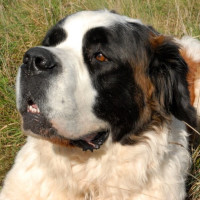Appearance of the Saint Bermastiff
|
| The Saint Bermastiff inherits traits from both its parent breeds. As with all mixed breeds, you can expect him to inherit more physical characteristics from either parent breed, or a relatively equal combination of traits from each. Typically, the Saint Bermastiff is large in size, with a short to moderately long, soft, downy coat, and often feathers on the legs. The Saint Bermastiff's head will be broad, with a square face, large ears and a short muzzle. Its lips and nose are black. The hybrid's tail will frequently be thick and broad close to the body, tapering to its full length. The Saint Bermastiff's body will appear short and thick with a broad, deep chest. His eyes are dark and round, with an expression of kindness and understanding. |
Temperament of the Saint Bermastiff
|
| The Saint Bermastiff inherits behavioral traits from its parents, the St. Bernard and Mastiff. The hybrid will be easy-going and affectionate, with a desire to please its humans. The Saint Bermastiff is unlikely to bark much, and sometimes prefers to be lazy. Both parent breeds are loyal to their humans, and this can be expected of the hybrid too. The St. Bernard and Mastiff are gentle dogs despite their large size, and both are protective of their humans; this will probably be the case in their offspring. As both breeds are patient and good with children, the hybrid should be too. Because of their size, interactions with small children should be monitored. Neither breed is aggressive, but because of their size, they could inadvertently hurt someone small. Although the hybrid is affectionate with its family, it will be wary of strangers and will probably need to be socialized from an early age in order to interact well with other animals. |
Needs and activities of the Saint Bermastiff
|
| The Saint Bermastiff's activity requirements vary according to the dog and the characteristics it has inherited from its parents. The Saint Bermastiff is often active, requiring regular exercise. A hybrid dog can live in an apartment, provided it takes short daily walks or has access to a small yard where it can be active. The Saint Bermastiff will cope well with cold temperatures, but will probably struggle in particularly hot weather. When it's hot, it's important to give your Saint Bermastiff plenty of water and make sure it has access to shade. |
Maintenance of the Saint Bermastiff
|
| Your Saint Bermastiff care will depend on the coat it inherits. If he inherits the smooth or rough coat of the St. Bernard, grooming will be relatively easy. Brush his coat with a stiff bristle brush every week to prevent shedding, and give him a bath if necessary with a mild soap designed for dogs. If the hybrid inherits the Mastiff's short coat, you'll need to brush it weekly and remove dead and loose hairs, especially during its two moulting seasons. The hybrid can inherit the Mastiff's increased oil production, which can lead to odor and the need for regular bathing, but you'll need to be careful not to remove the necessary oils. Regular brushing will help distribute the oils evenly. Regular ear cleaning is helpful to avoid infection and, as with all dogs, his teeth should be brushed every one to two weeks to ensure long-term dental health. Hybrids can be prone to bloat, so it's best to feed them two or three times a day rather than just one large meal. |









 English (United Kingdom)
English (United Kingdom)